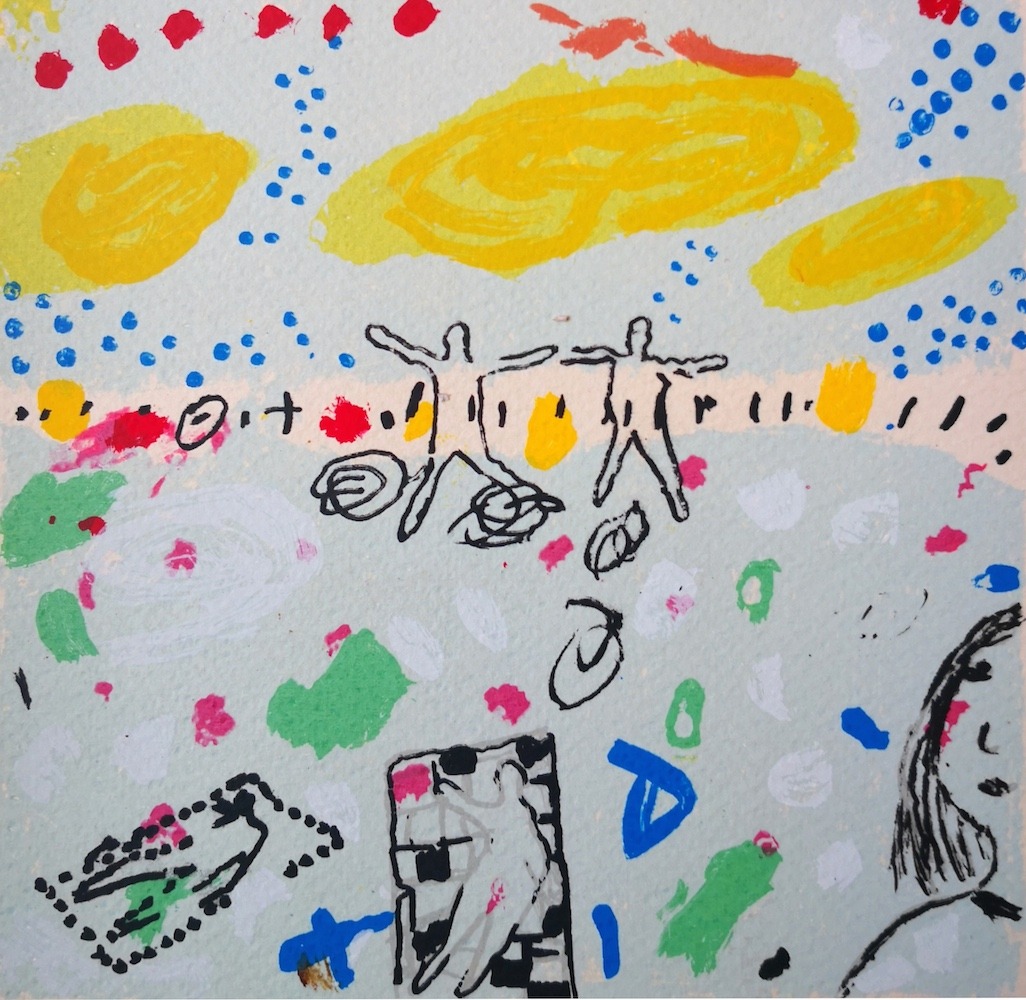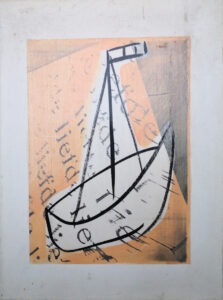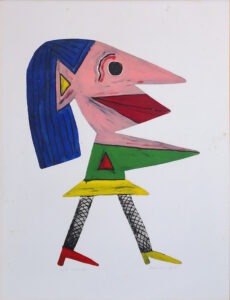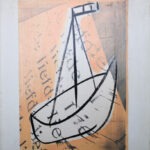COLLECTION ZOOM
Dominique Chan
BIOGRAPHY
Born
Born1950 Quimper-Frankrijk
Residence
The Netherlands
Education
Gerrit Rietveld Academy Amsterdam
The work of Dominique Chan by Anthonie Heidinga
No better way to understand the work of Dominique Chan to visit . Bonnefantenstraat his studio in Amsterdam No place , not even the living room and the garden , has escaped his painter drift . The floors sticking of the paint , the walls are hidden behind standing and hung paintings , one almost stumbles over colorfully painted sculptures and everything to decorate further falls in home and garden is decorated by a master . Work and home , as it were into one another , a chaotic color paradise . In short , here is an artist to work with a passion bordering on obsession work
That work , how is that to describe ? Women , many women , lying , standing , walking , with dress or bikini , sometimes hat, a glass torsend in hand or a shopping bag , often in the company of other women or a man, surrounded by the space tumbling cats, fish , cyclists , skaters , trees , clouds , and passionate color patches , stripes , dots and splashes that seem to go their own way . Lately women are the absolute key role to play in a series of portraits in which the busy bustle in the background was omitted .
The other women, fish , birds and so also return in its painted ceramics and especially in the gefiguurzaagde wooden sculptures that again press painted with the typical Chan motives .
Festive stories seem to be , in which some characters often have a fixed walk-on , such as the cat told (he adores his cat ) , but others picked out the memory of specific meetings or events not infrequently plate found in faraway places who visited Chan , as Hawaii, China or Thailand . Occasionally , the stories are not festive, like the assassination of Rabin , Nine Eleven , and – less dramatic – a friend with her leg in a cast , but even then the work something cheerful .
The merry -provoking nature of the work of Chan is due to the exuberant use of color – the paint comes straight from the tubes and jars – and the passionate , spontaneous way of drawing and filling level . The contours of the figures, as is often said women are drawn freehand with open tubes . Chan paints and paints and adheres little busy with art theoretical reflections . He is, and can be difficult labeling . Of course there were the influences of his teachers and fellow students at the Rietveld Academy and what he picked up from old masters and contemporaries . Of course he is a child of his time and his work is inconceivable without the history of expressionism , Cobra etc. One thing is certain : he certainly does not belong to the cerebral Conceptual artists , but to the “painter beasts” who have enough to cloth and paint . These are Chinese – French roots have played as is often assumed , a role not explain the particular meaning of the work of Chan . Of course , the visit to China , the land of his father , has left traces in the calligraphic way of drawing and the use of Chinese motifs and Chinese newspaper fragments in collages . But what the French side is concerned it is a coincidence that his lyrical expressionism more reminiscent Fauves like Matisse than to the North European expressionists like Kirchner and Nolde . But again , Dominique Chan is a different story .
Prelude door Mark van der Schaaf
Read in English, Dutch, French and German
Even seeing Dominique Chan’s work for the first time, the viewer realizes that this visual artist doesn’t allow himself to be held back. Combining apparent chaos with an intimate yet expressive palette, his compositions are uninhibited, open and full of life. In this regard Chan, despite his Rietveld Academy background, would appear to be decidedly Art Brut – ‘outsider’s’ art – but without the primitive or naive element. And certainly without the usual ‘outsider’s’ independence from culture, tradition and style. Dominique, no loner with emphasis on himself, is engaged with life and makes art with full-bore passion: unforced and lyrical.This publication, in its form, is a witness to Dominique’s engagement. Because more than a book that puts the artist at a distance raising respect towards his complete works, it aims at making you familiar with Dominique, his family’s pictures, ceramics, lyrics, paintings and other artistic expressions. And on top of it all, Dominique offers us a fresh layer of impressions: on the cover, a new dimension to his work, a new answer, a new perspective on what he has created.It makes this publication not just the dossier of an impressive artistic oeuvre, but adds a human dimension. Since, in addition to being a book for the art-lover, this is also a book for himself; a pause in a continuous work in progress. Dominique seldom reflects on what once was. Perhaps due to the creative urge or the limitation of the past as ‘fait accompli’. After all, to a progressive artist there’s nothing stranger than a story without motion. This owes not only to Dominique Chan’s French-Chinese background. He works, indeed, within a decor he doesn’t hide – his work is peculiarly French with a Chinese tint. But it speaks of larger themes; the art supersedes the artist.With his work, Dominique prods – no, compels – the viewer to fill in the picture. Dominique communicates with his art. Lively and expressive, it invites discovery and experience. Distancing oneself, let alone remaining untouched, is nearly impossible. Hence this book and its form, to bring you close to Dominique and closer to his art. To (get to) know Dominique is to cherish him, to hold him dear as a friend and a great artist. This book is enthusiastic witness.
Ook wie het werk van Dominique Chan voor de eerste keer ziet, voelt dat deze beeldend kunstenaar zich niet inhoudt of laat beperken. Zijn composities zijn ongeremd, openhartig en staan bol van levenslust, wat zich uit in expressieve kleuren, ogenschijnlijke chaos en vrolijke intimiteit. Wat dat betreft lijkt Dominique Chan ondanks zijn Rietveldachtergrond ingebed in Art Brut, in outsiderkunst – maar dan zonder het primitieve of naïeve. En zeker ook zonder de voor ‘outsiders’ gebruikelijke onafhankelijkheid van cultuur, traditie en mode. Dominique zondert zich niet af, legt het accent niet op de persoon, maar staat midden in het leven, met kunst vol overgave: ongedwongen en vol lyriek.
Deze uitgave getuigt daarvan, niet het minst door de vorm. Want meer dan een boek dat de kunstenaar op afstand zet en ontzag opwekt voor zijn oeuvre, wil het u dicht bij Dominique zelf brengen, met familiefoto’s, keramiek, tekst, schilderijen en andere kunstuitingen. Met daar bovenop nog een verse laag indrukken: op het doorslagpapier geeft Dominique zijn werk een extra dimensie, een nieuw antwoord of andere kijk op wat hij ooit creëerde.
Dit maakt deze uitgave niet alleen het artistiek dossier van een indrukwekkend oeuvre, maar geeft het boek ook een menselijke kant. Want naast een uitgave voor de kunstliefhebber, is het ook een weerslag voor hemzelf; een rustpunt in een niet aflatend work in progress. Reflecteren op wat ooit was, doet Dominique namelijk zelden. Misschien door het altijd willen scheppen, of door de beperking van het verleden als vaststaand feit. Niets vreemder voor een progressief kunstenaar tenslotte dan een onbewegelijk verhaal. Wat dat betreft zou het ook niet passen om Dominique Chan louter tegen zijn Frans-Chinese achtergrond te zetten. Het is een decor dat hij weliswaar niet verhult – want zijn werk ís Chinees getint, ís eigenzinnig Frans – maar tegelijk vertelt het grotere verhalen, overstijgt de kunst de kunstenaar.
Met zijn werk geeft Dominique een aanzet die de kijker zelf mag invullen, beter nog: moet invullen. Zoals gezegd wil Dominique zich uitspreken, is zijn werk levendig, expressief, en nodigt het uit tot ontdekken en ervaren. Afstand nemen is haast onmogelijk, laat staan onbewogen blijven. Vandaar de keuze voor dit boek en deze opzet, die je dicht bij de mens Dominique brengt en nog dichter bij zijn werk. Dominique (leren) kennen is hem koesteren, hem omarmen als vriend en als groot kunstenaar. Dit werk geeft daar enthousiast vorm aan
Même en voyant le travail de Dominique Chan pour la première fois, le spectateur se rend compte que cet artiste visuel ne se permet pas de retenue. En associant un chaos apparent à une palette intime tout en étant expressive, ses compositions sont sans inhibition, ouvertes et pleines de vie. A ce sujet, Chan, malgré son expérience acquise à la Rietveld Academy, semblerait être vraiment de l’Art Brut – l’art de “l’outsider”, mais sans l’élément primitif ou naïf. Et bien sûr sans l’indépendance habituelle de “l’outsider” vis à vis de la culture, de la tradition et du style. Dominique, qui n’est pas étranger à une certaine emphase sur lui-même, est fiancé à la vie et crée de l’art avec une passion débordante : naturelle et lyrique.
Cette publication, sous sa forme, est un témoignage de l’engagement de Dominique. Parce que c’est plus qu’un livre qui met l’artiste à une distance inspirant du respect envers ses travaux complets, il a pour objectif de vous familiariser avec Dominique, ses photos de famille, la céramique, les paroles de chanson, les peintures et d’autres expressions artistiques. Et cerise sur le gâteau, Dominique nous offre un nouveau niveau d’impressions : sur la couverture, une nouvelle dimension de son travail, une nouvelle réponse, une nouvelle perspective sur ce qu’il a créé.
Cela fait de cette publication non seulement le dossier d’une oeuvre artistique impressionnante, tout en lui ajoutant une dimension humaine. Depuis, en plus d’être un livre pour les amateurs d’art, c’est aussi un livre pour lui-même ; une pause dans un travail continuellement en évolution. Dominique réfléchit rarement sur ce qui a été. Peut-être en raison de cette urgence créative ou de la limitation du passé en tant que “fait accompli.” Après tout, pour un artiste progressiste, il n’y a rien de plus étrange qu’une histoire sans mouvement. Cela ne vient pas seulement des origines franco- chinoises de Dominique Chan. Il travaille, il est vrai, avec un décor qu’il ne cache pas, son travail est singulièrement français avec une teinte chinoise. Mais il parle de thèmes plus étendus ; l’art dépasse l’artiste.
Avec son travail, Dominique pousse, non, oblige le spectateur à créer l’image. Dominique communique avec son art. Vivant et expressif, il invite à la découverte et à l’expérience. Se distancer, et même rester insensible, est presque impossible. Voici donc ce livre et sa forme, pour vous rapprocher de Dominique et de son art. (Apprendre à) Connaître Dominique, c’est l’adorer, le considérer comme un ami et un grand artiste. Ce livre est un témoin enthousiaste.
Selbst wer die Kunst von Dominique Chan zum ersten Mal betrachtet, bemerkt, dass sich dieser bildende Künstler nicht eingrenzen lässt. Seine Kompositionen sind ungehemmt, offenherzig und voller Leben, was sich in expressiven Farben, augenscheinlichem Chaos und fröhlicher Intimität widerspiegelt. Was dies betrifft scheint Chan trotz seines Rietveld Akademie Hintergrundes in der “Art Brut”, der Outsider-Kunst, zuhause zu sein, allerdings ohne die primitiven und naiven Aspekte. Und sicherlich auch ohne die bekannte Unabhängigkeit von Kultur, Tradition und Stil der Outsider-Kunst. Dominique sondert sich nicht ab, legt den Nachruck nicht auf seine Person, sondern steht mitten im Leben und schafft Kunst voller Leidenschaft; ungezwungen und lyrisch. Diese Ausgabe will auch dank ihres Konzepts Zeuge dieser Kunstauffassung von Dominique sein. Denn statt Abstand zum Künstler zu schaffen und Respekt für sein Werk abzuverlangen, will dieses Buch den Leser näher zu Dominique selbst bringen mit Hilfe von Familienfotos, Keramiken, Texten, Gemälden und anderen Kunstwerken. Zum Abschluss bietet uns Dominique noch erfrischend neue Eindrücke: auf Seidenpapier gibt er seinen Arbeiten eine zusätzliche Dimension, eine neue Antwort oder einen anderen Blick auf sein Werk.Darum ist diese Ausgabe nicht allein ein Dossier eines eindrucksvollen Gesamtwerks, sondern verleiht dem Buch darüber hinaus auch eine menschliche Dimension. Mehr als nur eine Ausgabe für den Kunstliebhaber, hat dieses Buch auch für den Künstler selbst eine Wirkung, es wird zu einem Ruhepunkt in seinem fortwährenden künstlerischen Schaffen. Dominique reflektiert nämlich nur selten Vergangenes. Dies erklärt sich vielleicht aus seinem Schaffensdrang heraus oder aufgrund der Abgeschlossenheit der Vergangenheit. Nichts ist einem progressiven Künstler schließlich fremder als Starrheit. Dies verdankt Dominique Chan aber nicht nur seinen französisch-chinesischen Wurzeln. Seine Arbeiten verbergen seine Wurzeln nicht, sie sind chinesisch angehaucht und haben etwas eigensinnig Französisches. Allerdings spricht seine Kunst größere Themen an; die Kunst übersteigt den Künstler. Die Arbeiten von Dominique sind nur eine Vorgabe für den Betrachter, der sie mit Bedeutung ausfüllen muss. Dominique kommuniziert mit seiner Kunst. Sein Werk ist lebendig, expressiv und lädt zum Entdecken und Erfahren ein. Sich distanzieren und unbeeindruckt bleiben wird dabei fast unmöglich gemacht. Daher die Entscheidung für dieses Buch und dieses Konzept, das dem Betrachter den Künstler selbst und sein Werk näher bringt. Dominique kennen lernen bedeutet ihn als Freund und als Künstler schätzen zu lernen. Dieses Buch macht dies auf sehr enthusiastische Art möglich.
COLLECTIONS
AWARDS
EXHIBITIONS
MEDIA
The Book Aloha to download as pdf:





